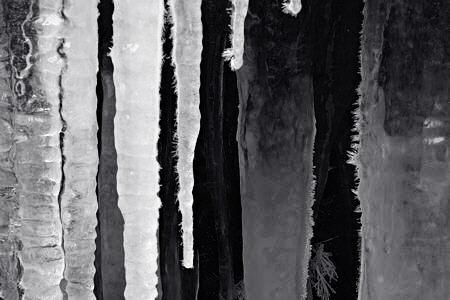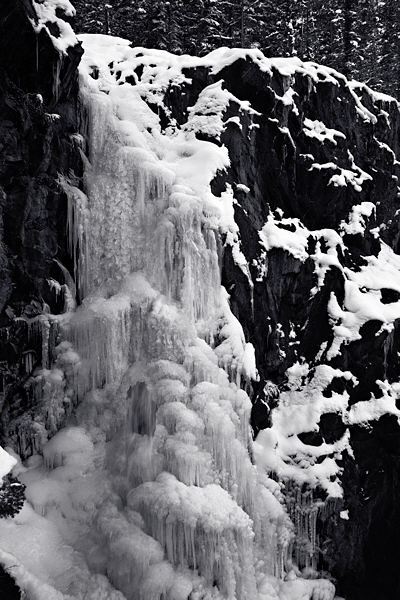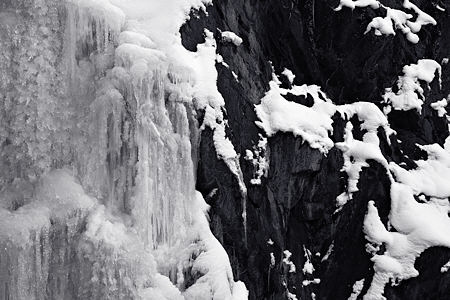
Winter is now here, having held off till mid-November. Last weekend I headed in to Pine Creek Falls, hoping to find an entrancing combination of ice, snow, water, and rock, as I had last year at this time. That’s when I had the first inklings of waterfalls as a potential subject. As I gear up for another round with Jay, attempting to come to grips with what that subject means to me, it seemed a good idea to return to the source.

I was disappointed. A week of cold had done more than I expected to encase the falls in ice. Ice climbers had already been out; they left behind an orange strap, though I wished it had been a pair of crampons. Getting to the top of the falls, pictured above (that’s less than a quarter of the total drop), was not without a slip or two. [Viewing note: if you can’t see detail within the dark areas, you should adjust your monitor brightness.]
One thing I’d been thinking that waterfalls have come to be about is the yin and yang of light and dark, flowing and fixed, soft and hard, perhaps even deeper things. But in this season the terms are at least upended, if not reversed. The pale ice is, to all appearances, as static as the rock. The more abstract detail below might almost be of a dark stream falling past snowy obstacles.

As for the stream itself, visible below the falls through gaps in the ice, it is actually the darkest element in its setting.

Maybe that’s the deeper lesson of yin and yang, that they can partake of and even transform into each other. Any eastern philosophers out there to shed enlightenment? Be that as it may, and whatever role it plays in my photographing of waterfalls, ultimately water is just one of those instinctual fascinations, like fire, its opposite…

Steve:
Thank goodness – I was afraid that A&P had gone out of business.
Yes, phase two is coming up. Looks like you have gathered some excellent material. Your frozen water work is especially compelling.
Still here, Jay, just exceptionally busy the last few weeks. I’m glad to have the time to return to this.
Steve,
I love the last image with its rounded curves.
Steve:
In the final image, I can persuade myself that I’m seeing a ghostly underwater waterfall. My first impression was that the surface reflected water falling elsewhere, but to do so it would have to have been both under and above its subject. However…perhaps some strategic muting is afoot. But even there, the outflow pattern would tend to mold the ice line into something more concave than the convexity that creates this perplexity. A statement on your part would be most welcome.
Jay,
You’re right, the light blurred area at the upper end of the dark water is where it is going over some stones and foaming a bit. The water surface is actually several inches beneath the ice, which was apparently formed when the water was higher. Lately (but not when I made the photograph) this has the effect of making the dark area resemble a man wearing a hat.
Steve, brrrrrrrrr. And we’ll be there (or near there) in not too many days.
I like the reversal of the concept — both the concept and the art itself. And the final image is very like a photograph from an airplane. Birgit’s comment seems so right for her love of those curves….
I’m too muddled this evening to make much sense, but I’m glad to see you returned to this spot and are visually reconsidering it. I hope you were wearing crampons.
Steve:
I tried to yin-yang your icicle image by giving it a twist. I’m reporting this, not from pride in my accomplishment, but rather to sound a cautionary note. Neither your image nor yin-yang was well served in the process.
Keeping the complementary principle of yin-yang in mind, however, is sound – especially when dealing with the strong contrasts and interrelated phenomena that your images portray. In fact yin-yang might also be described as y-y, to indicate the equality of the components. It’s not yin being yanged, nor is it yin and its side-kick yang, but rather a symmetrical relationship. And the y-y does seem to imply a degree of similarity, one “y” to another.
This may be shallow of me, but I can’t grasp fire and water as being y-y together. But the chill brings the erstwhile flowing water and the stalwart cliff into a common embrace. Somewhere, enfolded in that is the y-y as a thought and an image.
Steve, I like these new images very much. I find them even more visually satisfying than what I remember of the non-frozen waterfalls. In addition to the eastern philosophical perspective you are exploring, the images look oriental because of the way space is represented, stacked somewhat vertically and sitting on the picture plane (the first 3 images, anyway). They are also reminiscent of Clifford Still.
Your note about monitor adjustment brings to mind another aspect of these works; that yin and yang refer to opposites, but in fact there are a lot of mid-tones within each that give it richness and depth. My monitor is pretty well calibrated, but if I squint I can eliminate many of those mid-tones, and the compositions are nowhere near as strong. This in fact is right in line w/ y-y, as the classic yin/yang symbol has the black shape pushing into the white and vice versa, as well as a circle of each within the boundaries of its opposite.
My hope is that we can all achieve y-y-y in our work, the third “y” of course being yen.
Steve – from my humble understanding…light and dark are often different aspects of the same phenomenon. A discerning and discriminating mind aprehends them both. Different minds will see different things. The purified mind will perceive everything.
These images reveal the transient nature of things to me. They exude a warmth as the inevitable energy of continual change begs to tumble forth from the immediate moment seized in each image…..maybe there is some fire there afterall ; )
And as I’m sure you know:
no expectation=no disappointment – the yin and yang of a contented mind.
I did a painting “Yin & Yang” earlier in the year based around two cats in the yin and yang positions. Maybe they are yogis!
It’s tucked away in my myspace if you let the images run/or log in and view them at:
http://www.myspace.com/mjillingworth
There’s some hot and cold with these cool (or is it hot) cats!
MJ,
I could not find your Yin and Yang during my quick break at work. I did not have enough time to study your entire web page.
David–The Still comparison is right on. The first photograph has that same sense of switching scale. These could be giant prehistoric icicles, or these could be a close up of something hanging off your gutter. Same thing with Still. His work can be seen as huge as the cosmos or simply a very very close look at something small.
The form behind the icicles (bottom right) is also fascinating and reminiscent of Still. It could be part of tree branch, or it could be a leggy dead bug folded into itself. Or simply more ice. The detail there breaks up the uniformity of the image, like a thin streak of red might break up an otherwise black Still work.
All these works are powerful as abstractions–no small feat given the distracting romance of waterfalls, ice, and water as subjects.
You’re right on about the romance of waterfalls being a distraction. I live in a town famous for it gorges. Lots of local painters and photographers make pictures of them but most are little more than postcards (perhaps less, due to the artistic pretensions). These images are miserable failures compared to the power of standing in front of an actual waterfall. Getting in to the landscape, as Steve does here, seems to be the best way of transcending the cliche.
I love the top image too.
Thank you for the comments, both philosophic and artistic.
A good point about the midtones, David. These were rather quickly dashed off, and were therefore handled in a sort of “standard” mode (for me, anyway), but I will go back and experiment more with the tonality to study the effects, and may find something I like better, or at least learn something.
The Still comparison is one we’ve looked at before (Still and falling water), but I don’t recall thinking about the scale ambiguity of his work before. Thanks for adding that, McFawn!
By the way, the partially hidden detail in the lower right corner of the icicle image is hoarfrost on a bit of grass.
Arthur: Yes, the postcards and clichés are what kept me from even thinking about waterfalls as a subject for a long time. That’s not to claim I’ve necessarily done anything too original or exciting. But it is at least serving as a sort of classroom for me.
midtones…These were rather quickly dashed off, and were therefore handled in a sort of “standard” mode (for me, anyway), but I will go back and experiment more…
Actually, my point was that the midtones are already working, and that’s what makes it richer than if it were just dark and light w/ nothing in-between.
David,
That is what I took from your comment, which I guess means that my “standard” approach is working here, at least well enough. But I think I can still learn a lot by trying variations, even if I don’t end up adopting them. For example, I’d like to look at the effect of reducing the overall contrast between dark and light, or of keeping that contrast fixed while moving more tones toward the middle. In yin/yang terms (convenient, but I don’t take them tooo seriously): is it important to have the two clearly delineated, or does blurring the boundary have its own appeal?
I think reducing the contrast will give you yi and yan :)
My understanding of the yin/yang concept is simply that the whole is made up of many opposites, and that at least a portion of each is contained in the other. I’m not aware of any specific rules as to how the concept should be applied.
Steve:
Caught it. I was wondering what it was, among any things, about your first shot. The hoarfrost on the leggy shapes of the icicles resembles your horses somewhat.
Arthur:
Many years ago my brother-in-law took me one night to a pond below one of your waterfalls where we seined small fish which were then taken home and fried up. I can no longer remember the name of the falls or the species of fish, but the experience came close to what you are describing here.
Arthur
I agree, you have to really engage with the subject matter and your inspiration to bring out a true creative outcome – Steve achieves this here. Template styles and cliche art both constrain creativity.